Preparing for China: Not as Tough as It Seems
sharing things I wish I knew, my tips & tricks, and the nitty gritty of prep
If you’re reading this, you’re probably thinking about visiting China, which is AWESOME! It’s a big trip, and I’m excited for you. Here’s a table of contents (in addition to the built-in panel on the left hand side) to help you navigate:
table of contents
notes for before you go // intentional preparation is required, and I break down each key piece here! From visas, to apps to download, to VPN & technology-related questions, to packing essentials…we’re going to set you up for success :)
notes for the flight // where we discuss important questions like, which airport? What’s plane food like? & how to tackle jet lag!
notes for arrival // busting any myths related to the customs & border protection process so you know *generally* what to expect 😘
things I wish I knew // **specifically Shanghai-related** sharing observations that took me by surprise & “culture shock” moments
notes for before you go
(because going to China, for many, is not as simple as just packing your carry-on)
the tourist visa
In 2024, China implemented new visa-free policies for 24/72/144-hour visits. What that means is, if you’re only planning to visit China for 6 days or under, you can travel to China visa-free and you don’t need to go through the harrowing adventures of getting a Chinese tourist visa.
But if you’re not one of those lucky folks, and are a US citizen that wants to gallivant the country of China for longer than 144 hours (like me & my husband), you’ll have to apply for a Chinese tourist visa.
And people aren’t exaggerating—the visa procedure is not a cake walk (like many government-owned processes, it is extremely antiquated). It requires a portfolio of documents, your passport (so get one of these first, if you don’t have one already), money (the 2024 processing fee was $140 per visa), and steadfast patience. I’ll walk you through some frequently asked questions:
Q: How do I even get started?
A: Navigate to the Chinese Embassy website’s page on “Requirements and Procedures for Chinese Visa Applicants.” At the bottom of that page, instructions are detailed under II, “Process of Visa Application,” where your first step is to create an account on the “China Online Visa Application (COVA)” website to fill out the COVA form (think of it as a “personal portal” to which your application will be linked to). While you have filled this out online, the embassy will also require you to print this form out and submit it again in person.
Q: Is it worth engaging a third party visa service?
A: If you search this, many forums will highly recommend you use a third party service to increase your chances of getting the right documents together for the embassy. For us, we didn’t think it was worth it since we were within driving distance of the Chinese Embassy (in Washington D.C.), and also had family there to pick up our passports after the visas were issued. Third-party services are quite pricey (approx. $500 per person when we looked into it), so I’d only recommend using them if you aren’t able to travel to D.C. easily. The act of gathering the required documents itself was fairly doable, albeit tedious!
Q: Do I have to be the one to drop off the documents and pick up the passport?
A: Yes to the former—the embassy staff will need you to be there in person to confirm your identity and clarify parts of your application (i.e., they needed me to fill out a job history section that I somehow missed). No to the latter—you can have someone else pick up your passport, as they only need the receipt slip from your submission and to bring a check for the visa processing fee.
Q: Am I able to contact the Chinese Embassy while they’re processing my application?
A: Yes—it is a pleasant surprise to find that the email on their website is quite functional. They required an additional document from my husband, so that’s how we found out that their staff will reach out to you for any additional needs and respond within 24 hours (albeit, the responses aren’t always clear; you can’t have it all 🤷♀️). The email we corresponded with: washington_visa@csm.mfa.gov.cn (中国驻美国大使馆 ).
Q: How do I know if my visa was successfully issued, and when to pick up my passport?
A: The short answer is, email them to ask. While the Chinese Embassy provides an estimate of 4 business days for the regular processing service and 3 business days for the express processing service on their website, reality can be very different. The embassy staff gave me an estimated date of completion 7 business days after my initial appointment, while my husband was only told that he’d receive a phone call eventually (you can see these details marked on our visa slips). After those 7 business days, neither of us received an email nor a phone call informing us about our passports being ready for pick up, and we had to email the embassy to get a confirmation that they weren’t ready yet. (Of course, you can just show up without a confirmation, but who wants to waste a trip?)
Q: Do I get to choose the number of entries the visa gets approved for?
A: When we applied, there wasn’t a way for us to explicitly choose the number of entries, validity, or duration of stay for our visas. It seems like Chinese tourist visas for American citizens default to having a 10-year validity (details on Travel China Guide)… 👀
lastly, gonna leave you with my holy grails:
The best primary resource I found was the Chinese Embassy site; they’ll have the most up-to-date info on visa policies (even though it’s hard to navigate)
The best secondary resource I found is from Travel China Guide; they do a great job consolidating all of the info from the Chinese Embassy site and providing additional background in an easy-to-understand manner
the technology prep
Okay, now that you have your passport and visa processing (honestly, the hardest part), the next thing is to make sure you can communicate and navigate when you’re in China!
The stereotype that China is “in its own little bubble” is, sadly, true. Here are some key things you’ll need to think about for seamless assimilation:
1) VPN
purpose: once you download and turn on a VPN app on your phone or laptop, it’ll allow you to use Western websites like Netflix, Facebook, Instagram, Google, etc. Without a VPN, you won’t be able to load these sites in China even if you have Wi-Fi or cellular data.
options: Astrill, Ladder (both recommended by thetravelingqipao on IG), Let’sVPN, and shadowrocket (city locals use this one!)
our experience: search results will give you a lot of mixed reviews on VPN’s and how they perform in China since China is constantly updating their security (i.e., NordVPN and ExpressVPN both didn’t work for us, but might for others). We ended up trying Astrill ($30/month, and we canceled after our trip). Astrill worked decently for my Samsung phone, but didn’t do as well on my iPad (loaded the sites, but would be super slow) or on my laptop (the VPN itself wouldn’t work at all). My brother used Let’sVPN, which I had very positive interactions with:
It had a sleek chic user interface that was more intuitive to use
It worked on my iPad and my android phone (I didn’t try it with my laptop)
It was 1/5th of the price of Astrill, at just $6.69/month for the Platinum version, or $4.69/month for the regular version
tips:
download and set up the VPN before you land, or else it’ll be blocked for you
depending on the VPN, you can install it on multiple devices and multiple people/devices can utilize the VPN at the same time. This is how my husband and I could both use Astrill on one payment, and how I could use my brother’s Let’sVPN
the VPN may cause some Chinese websites to be inoperable, so don’t freak out if a Chinese app is suddenly super slow. See if your VPN is turned on first, and just turn it off and try again ✌️
2) SIM Card
purpose: enables you to have a local phone number and use cellular data. Super important if you want to be able to make phone calls, send texts, use the internet on-the-go without Wi-Fi, or use navigational apps
options: physical SIM cards
our experience: We ended up getting a physical SIM card that provided 10GB of data for ¥200 each (~$30.00/each). The service staff are very helpful in walking you through the process, and also provide the little pin for you to open the SIM card tray in your phone. And in case you were wondering, for us 10GB was more than enough since (1) we had hotel Wi-Fi and (2) took turns navigating, splitting the data usage among 3 phones. By the end of the trip I had only used 2-3GB out of the 10GB!
tips:
you’ll see a lot of buzz about eSIMs (i.e., AIRALO is frequently mentioned) and loading these before you land—don’t waste your time on them! eSIMs don’t tend to work in China, so your best bet is to purchase a physical SIM card when you land
if you’re worried you won’t find the SIM card vendors in the airport, don’t. They’ll make themselves very known to you as you’re headed to luggage pick-up
the best place to buy a SIM card as a foreigner really is at the airport (as a person who always finds airport items overpriced, it was hard for me to digest this at first). This is because they require passport validation to get a SIM card working for an international phone, and a couple of other procedures that local vendors aren’t used to performing since their main consumer body are Chinese citizens (unlike in Berlin, Germany, where we could walk into any shopping mall and find a cellular store that could help us out). So let the experts at the airport handle it for you :)
3) Payment
purpose: ever since around 2020, China seems to have swiftly modernized to where the majority of people use mobile pay apps to make purchases (even at the mom & pop street stalls!). That said, all storefronts are mandated to accept cash, so if you use paper notes and coins, people will still accept your payment.
options: AliPay, WeChat Pay (a function of the main WeChat app), cash!
our experience: since our only credit card that waived international fees was issued by American Express (we didn’t feel like getting another credit card), we chose to use WeChat Pay. That said, while we were in China, we still tried to use cash as much as we could since there was a spending cap on the American Express (read the fine print, folks!).
tips:
AliPay doesn’t accept American Express credit cards
since WeChat is used mainly for communication (like WhatsApp, Facebook Messenger, etc.), it’ll take a few clicks to navigate to the payment QR code compared with AliPay
read the fine print on spending caps, and make sure you’re prepared with a Plan B if your mobile transaction is denied in that instance
4) Other Useful Apps
for directions & navigation: even with a VPN, Google Maps won’t be able to help you out since it doesn’t have extensive coverage of China 💔
options: Baidu Maps (百度地图, bǎidù dìtú); Gaode Maps/AutoNavi (高德地图, gāodé dìtú); Apple Maps; Tencent Maps
our experience: we used Baidu Maps, which is known for being the “Google Maps of China.” With such a reputation, I was definitely expecting it to perform just as well as Google Maps, but I was severely let down. Baidu Maps didn’t seem to have up-to-date information on the operational hours and addresses of locations we wanted to visit that weren’t your “super established and frequently visited” places. For example, there was a coffee shop that showed up on Baidu Maps but when we arrived, it had closed and was already replaced with another storefront. There was another instance where I was trying to locate a street vendor with an address from Instagram, just to be led to a neighborhood with no such street stall… frustratingly, there were probably 4-5 experiences like this.
tips:
it wasn’t until the end of my trip that I heard more about Gaode Maps… which, word on the street says has more English and more up-to-date information. Next time I visit I’ll be trying this out! (and if you have experience using it, please comment below on how it was for you)
don’t rely on asking locals for directions, we had multiple instances where locals were just giving an answer to appease us so we would stop bothering them, but they were inaccurate (this could also be more of a behavioral pattern of the older generation)
China Travel Tips has an article comparing the different Chinese navigational apps, with pros & cons & ratings to boot 💥
for transportation: besides your feet, of course! From calling something like an Uber or Lyft, to taking the metro & bus, we’re breaking it down below:
options:
Didi App (滴滴出行, dīdī chūxíng)—a taxi app embedded inside WeChat and Alipay, but also a standalone app
For public transportation:
Physical metro card
Download the Shanghai Metro DaDuHui (Metro大都会, dàdūhuì) to your WeChat or AliPay
our experience: we used a physical metro card that you can purchase at any station’s service desk. To reload the physical metro card, you use a kiosk that is separate from the normal metro ticket machine used to buy single journey/day passes. It was surprisingly difficult to find reloading kiosks that accepted cash (we found 1 out of every 10 or so that did), so have your mobile payment option handy. In total, we spent about ¥250.00 each on metro fare for 2 weeks worth of exploring the city, and didn’t have the need to use the Didi App.
tips:
a resource on using the Didi App
a resource on Shanghai Metro Ticket Types and How to Take Shanghai Metro
all of the metro stations close sometime between 10:00 PM - 11:00 PM (started as a COVID precaution and has remained), so double check your station’s hours
bus fare is a standard ¥2.00 for as many stops as you want to take
metro fare varies depending on how many stops you ride, but varies from ¥3.00 - ¥9.00+
for food & reservations: think like the equivalent to America’s Yelp and Resi; these apps are helpful to make reservations for events, sightseeing attractions, and restaurants, and to get Chinese locals’ recommendations
options:
Dianping (大众点评, dàzhòng diǎnpíng)—literally translates to “masses of people comment;” the tried and true review app that Chinese locals use to rate local businesses and share their reviews
REDnote (小红书, xiǎohóngshū)—a Chinese Instagram that is heavily shortform video dominated; creators typically post on lifestyle, food recommendations, etc.
our experience:
Dianping—long story short: I gained a massive appreciation for this app
its search function puts Yelp to shame: you can type a business type, food type (i.e., pizza, Italian, insert-niche-street-food-item), and results are almost always on point
you can search near a specific metro station, which streamlines daily itinerary planning
you’re able to text with businesses/vendors any questions you have prior to a visit
discounts and deals are helpfully provided on the business’s page and are easily accessible for you to use with your purchase
REDnote—I mostly used this before arriving to Shanghai and just watched a bunch of Chinese local foodie and travel vloggers and noted down places that intrigued me. While I was actually in Shanghai, I used this as a reference back to the posts I had bookmarked!
tips:
there’s no English version, so here’s a helpful resource on How to Use Dianping
a resource on How to Use REDnote
a reservation is frequently needed to visit any public indoor attraction—for example, we needed to make reservations for all museums and even the city’s public library! You can easily do this with your passport (if you’re a foreigner) or Chinese Citizenship ID (if you’re a local) through the Dianping app
a word of caution about Dianping, REDnote, and even Instagram: you’ll often see clickbait content of photogenic places to visit, but the reality behind these pretty places are that oftentimes they are still under construction or not yet open to the public because of how new they are, so take those influencers with a grain of salt! After 1-2 busts, I realized the classic destinations were better worth my limited travel time.
for language translation: for those moments where you don’t know a character or a phrase or just need help with a bubble tea menu (because dang, those are DIFFICULT to understand)
options: Hanping Lite, Pleco, Google Translate with VPN
our experience: my brother and I have always been Hanping Lite users, so naturally we onboarded my husband to that as well. What I love about Hanping Lite (I haven’t found the need to buy the pro version) is the character drawing option, which lets you write a character you see and it’ll translate. Perfect for those words you don’t know, and thus, can’t use pīnyīn to find.
tips:
a resource on Hanping Lite vs. Pleco
a resource for learning Chinese
these translation apps aren’t as useful for colloquial words, phrases, or situations you find yourself in. In those moments I use Baidu’s search engine to try and piece it together
5) Outlet converters
purpose: enables you to charge your electronics without shorting out anything! Don’t forget about ‘em.
options: three types of outlets: Type A, I, and C
our experience: since we already had the Type C outlet converter from a Europe trip, we decided to buy a Type I converter just to be safe (since I wasn’t sure if all three socket types are always offered, or if it was a mixed bag depending on the place). It turns out that most (if not all) power plugs in Shanghai had all three socket types available, so you’re fine if you have at least one out of the three of these outlet converters. Our hotel even had USB ports so we could’ve used those if we didn’t have the right outlet converters for our phones and smaller electronics.
tips: a resource on Power Plugs / Sockets in China
the packing essentials 🧳
Bug spray—mosquitos seem to be around all seasons outside of winter; we went in October and I was still bitten alive (mosquitos also just seem to love me so you may be fine 🙃)
Hand sanitizer—for meals, bathroom trips, or just when you’re feeling grimy from all of the public transit surfaces you’ve come into contact with! While most public bathrooms have soap now, not all restaurants have a personal bathroom that’s conveniently located in their storefront, so having hand sanitizer is just comforting.
Napkins—or facial tissue, either work! Street vendors rarely provide napkins, casual eateries provide it 50% of the time (i.e., a communal supply at the register), & fancier restaurants provide wet wipes that if you open, you’ll get charged for
Power bank—you’ll be using your phone a LOT. For navigation, for payment, for fun! I didn’t realize how drained my phone would be, and can only thank my brother who came prepared with two power banks. But if you forget to bring one, there are power bank renting stations available throughout the city (you’ll see a lot of the locals using them too)
Umbrella—a super packable/portable one that you can bring around as frequently as conveniently possible. Some months are worse than others, but the weather in Shanghai is generally very humid and there can be a drizzle/heavy rain a couple times a week
notes for the flight
on #airplanemode
Approximately a ~19 hour flight later, you’ll find yourself on the other side of the globe. The time difference is a full 12 hours (unless it’s Daylights Savings time, to which it’ll be 13 hours), so jet lag can be fierce.
options: there are two airports you can fly into:
Shanghai Hongqiao International Airport (SHA) (上海虹桥国际机场; shànghǎi hóngqiáo guójì jīchǎng)—main hub for domestic activity and some nearby Asian countries like South Korea and Japan, with limited international routes
Shanghai Pudong International Airport (PVG) (上海浦东国际机场; shànghǎi pǔdōng guójì jīchǎng)—offers flights to over 200 destinations worldwide, served by over 80 airlines
our experience: I have always flown into the Pudong International Airport (there are more flight options, and less layovers this way), and I typically always have family available to pick me up. But don’t worry, PVG is connected to the subway so you can ride into the city :)
On the topic of the jet lag—my modus operandi is to stay awake the entire time with minimal naps (great time for a movie marathon), and just let pure exhaustion do the work after I land.
tips: resources I found helpful:
Pudong vs. Hongqiao Airport from travelasker.com
Which Shanghai Airport to Use from letstraveltochina.com
the flight food
options: the typical flight offering is 2 full meals + 1 meal-ish/substantial snack. At each meal, they’ll present you with two options and you can select one of them. Depending on your airline, this could be a very exciting experience…or a dreadful one…
our experience: normally we fly on non-American airlines, so this was my first time eating Delta flight meals…and I did not enjoy the experience. The food we had on Delta felt more heavy and oily, and just all around wasn’t easy on my stomach (crossing my fingers that they’ll do better next time).
meal notes

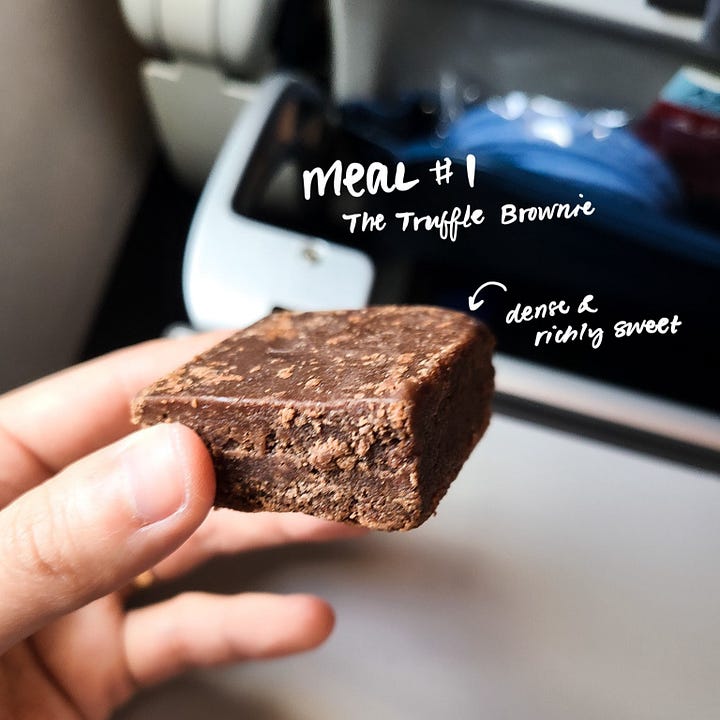
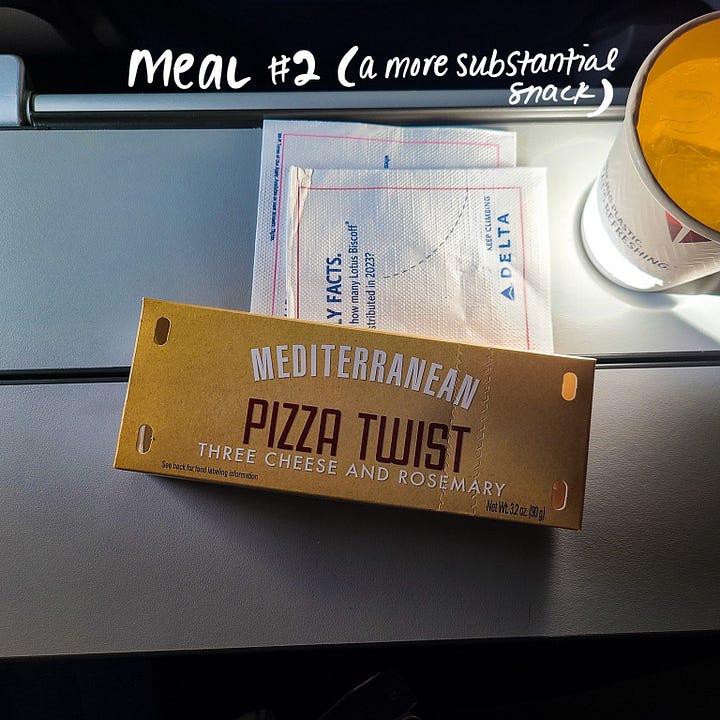
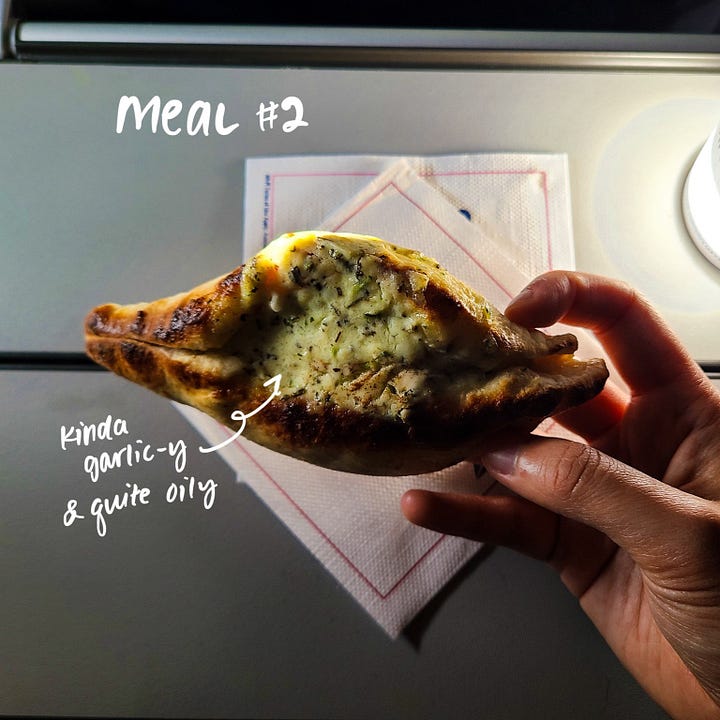
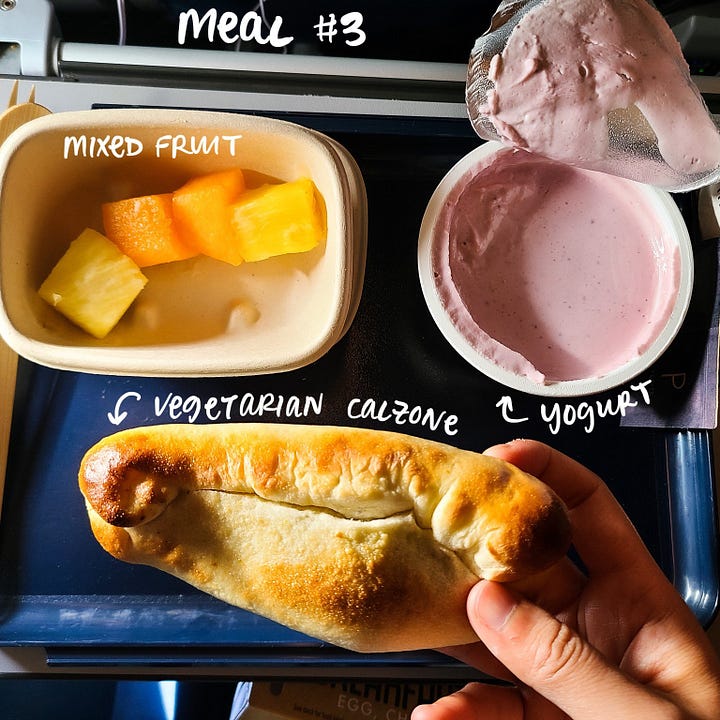
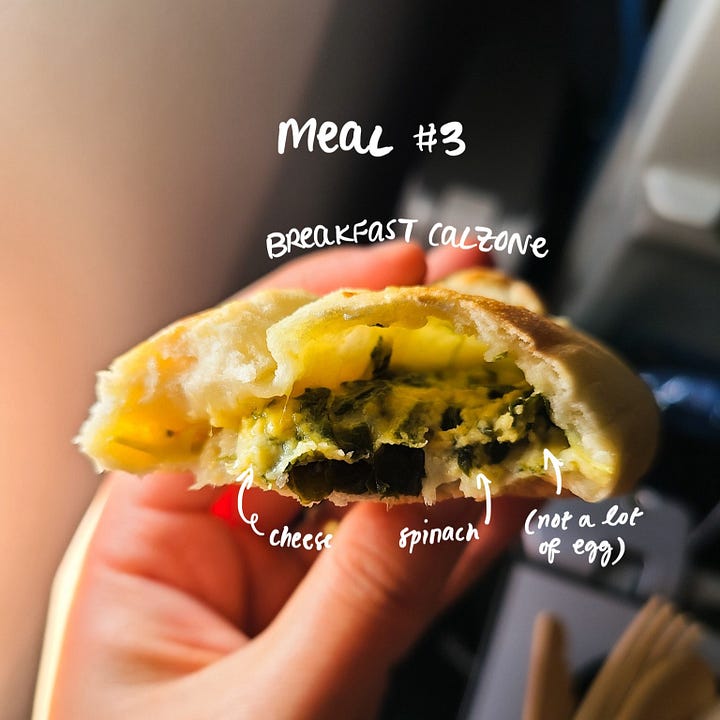
tips: If you’re able to choose, I highly recommend you fly on a non-American airline (i.e., China Eastern) for tastier meals that feel better for you, or just come loaded with snacks, if you’re particular with food like me!
notes for arrival
on the customs & border protection process
You’ve survived the flight, you’re here, you did it!! Now onto the whirlwind of customs. Here’s our experience, so you know what to expect:
key items to have ready for customs 👇
Passport—have this ready, this is where they’ll give you an arrival stamp!
Arrival Card—you’ll receive this during your flight from one of the flight attendants; I highly recommend you fill this out prior to deboarding so there’s one less thing to think about. But if you forget or lose yours, they have a station with pens and more arrival cards closer to the customs line.
Fingerprint Voucher—at the Pudong Airport, they have 10-15 self-operating kiosks you can just walk up to and follow screen prompts to get your fingerprints scanned. There are multiple areas with these kiosks too, so if one area looks super busy, just keep walking and you’ll see another section with more.
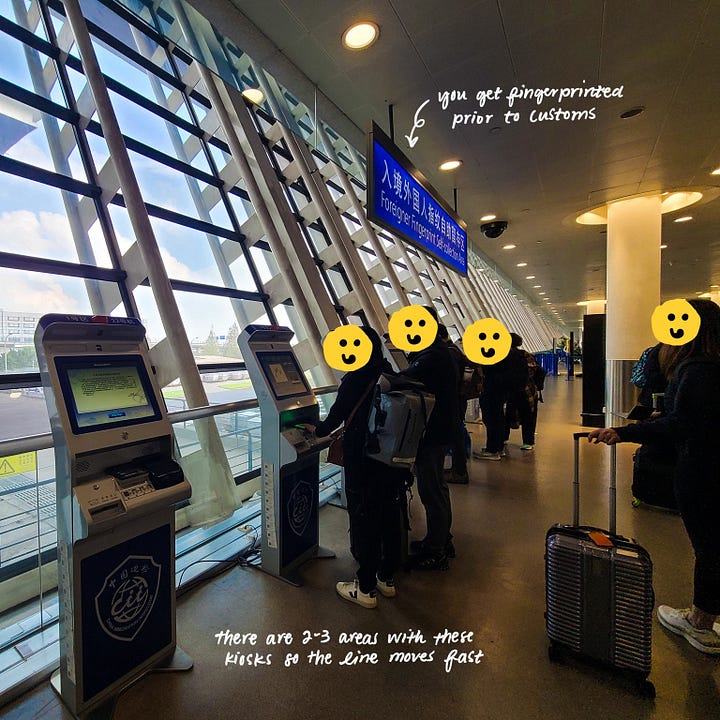

👉 Once you get through customs, you’ll head to baggage claim to pick up any checked luggage you’re bringing. After that, you’ll encounter a variety of SIM card vendors on your way to the departure doors (view section on SIM card for more info).
things I wish I knew
**culture shock and observations that took me by surprise that are specifically Shanghai-related. I can’t speak for other Chinese cities :)
The city is very paper-saving—there’s a limited availability of public toilet paper, napkins, etc.
The city isn’t very plastic-saving—plastic bags are the go-to package for street food
Dairy-free options aren’t as widespread as you’d think—with Asians having the highest percentage of lactase deficiency1, you’d think almond/oat milk would be more prevalent…but many beverage treat shops only sell their menu items with full-fat milk and don’t offer substitutions.
our experience: about 1 out of 5 bubble tea menus offer coconut and soy milk, but only built into menu items and it’s not a norm to ask for substitution because it would cause the intended taste to be off
Street food vendors are being consolidated to neighborhoods away from the city’s center—my cousin said this was to give the city center a cleaner look, but I’m sharing this so you know you may have to travel a little bit to find actual street vendors! We found good options in Yangsi.
“No smoking” signs are never heeded—just be prepared to encounter secondhand smoke almost everywhere…locals don’t give two craps about the signage and service staff don’t seem to care enough to enforce the rule either.
Take the words of shop clerks with a grain of salt—most shop clerks (especially the ones running small street shops) will say anything to sell you the product. Is it water resistant? Real silk? Easy to wash? They’ll say “yes” to all of these questions even if the product you’re buying really isn’t any of those characteristics.
Very safe—the streets are extremely safe. No violence, no pick-pocketers, and this is mostly due to two factors: (1) sooo many cameras EVERYWHERE, and (2) a lot of people have migrated to digital payment, so there’s not as many conventional wallets to steal anymore.
Foreigner-friendly—there’s a myth that people will ask to take a photo with you if you don’t look Asian…which may have once been true, but at this point in globalization, it isn’t anymore. Shanghai locals (especially vendors) are very accommodating with your level of Chinese, and just assume you’re an international student studying abroad
You don’t need to be fluent in Chinese—while a lot of signs, menus, etc. are in Chinese, you’d be surprised with how many of the vendors and retail staff know enough English to converse with you! So the language barrier, while present, isn’t absolutely debilitating.
Shanghai hosts one of the most festive Halloween celebrations in China—so if you’re big into “Spooky Season,” maybe a bucketlist item is to visit Shanghai at the end of October! Shanghai’s Halloween vibes are classy and chic, especially in the French Concession city-walk streets.
& in closing
Phew! While this post isn’t nearly as long as some of my other Shanghai-related guides, it’s still a longer read and I appreciate you for making it this far 😊 I hope this helps in planning your own visit to China, and if there are any unanswered questions, please comment below and I’ll try my best to answer❤️
check out my other Shanghai posts, linked below 👇
The Shanghai Travel Guide I Wish I'd Had
Where I share key places to see, from the notable landmarks to the hidden local gems, and fun facts & digestible pieces of history when applicable. Plus a self-illustrated map! As the name suggests, this is everything I wish I had to navigate this beautiful city. ✨
Eat Like a Local: a Guide to Chinese Cuisine
The unabridged answer to the question, "How was the food?!" Also known as, a bucket list of food you need to try when you're in Shanghai, but really probably any big city in China. Come check out this menu resource I've put together for you 😊
Where To Eat in Shanghai
A list of the restaurants we tried in Shanghai 🍴 sharing everything you need to know about our experience, the restaurant's vibe, what we ordered, and if it is overall worth going to. This post will give you a peek into the Shanghai food scene... 👀
Why Are More People Becoming Lactose Intolerant?—up to 100% of Asians have lactase deficiency!!







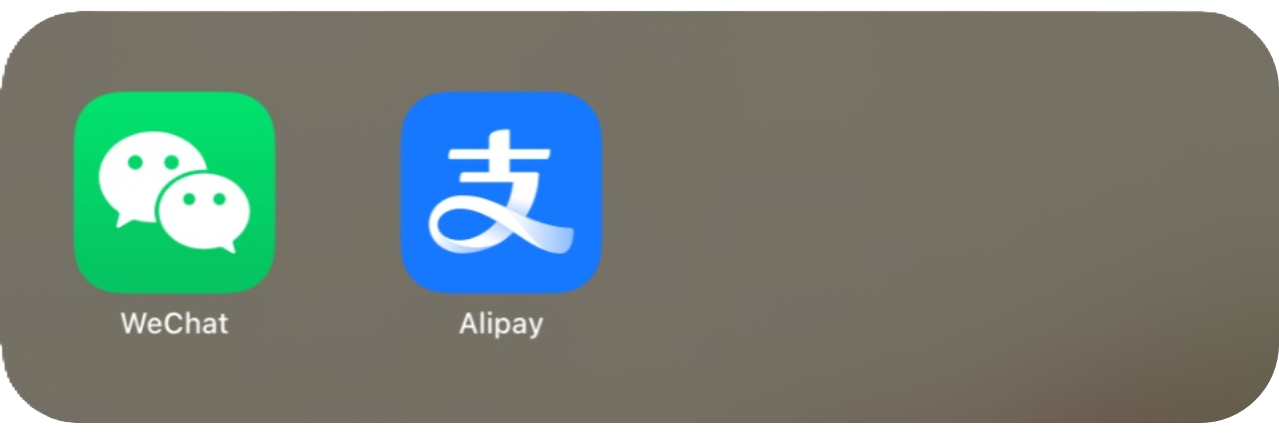




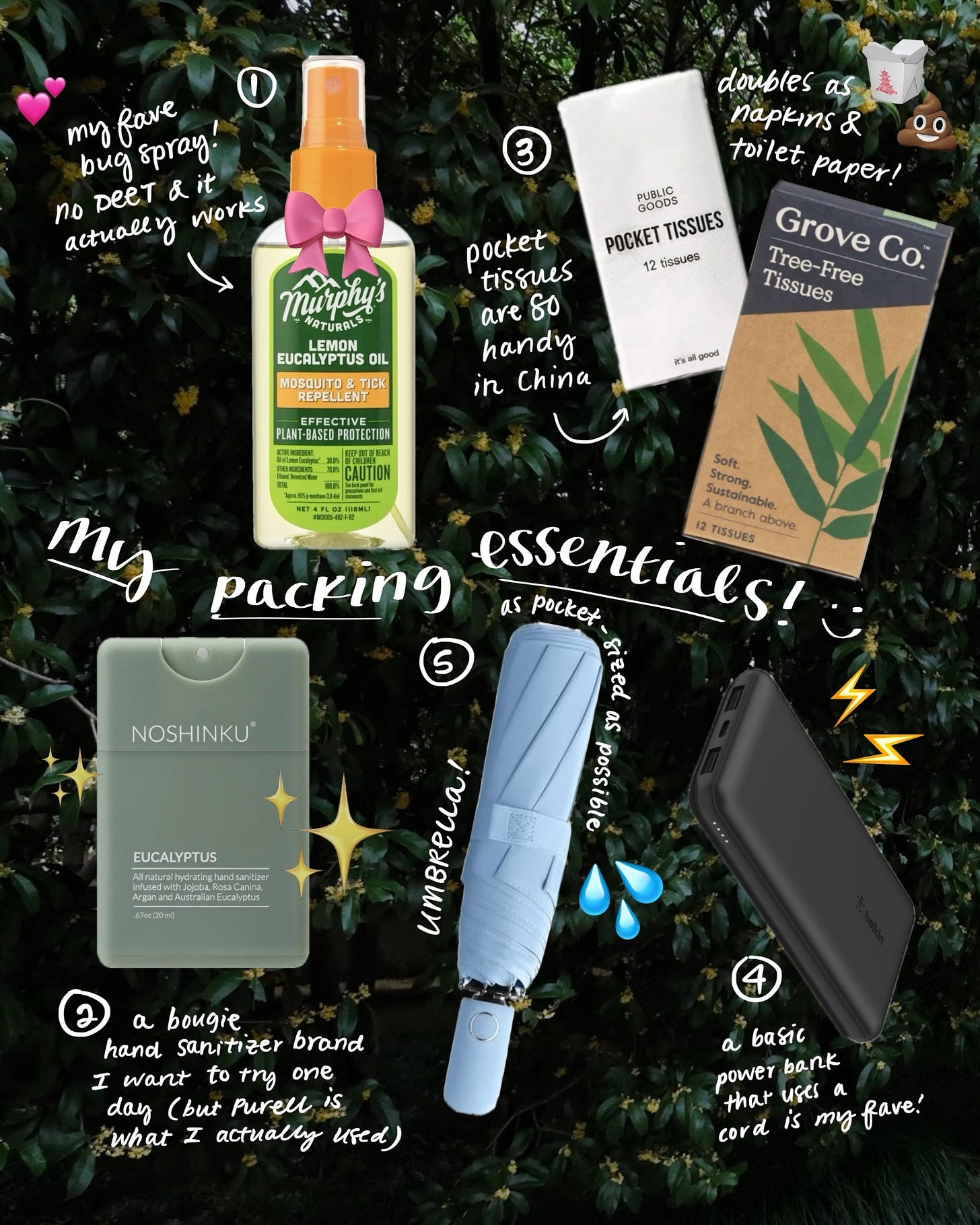
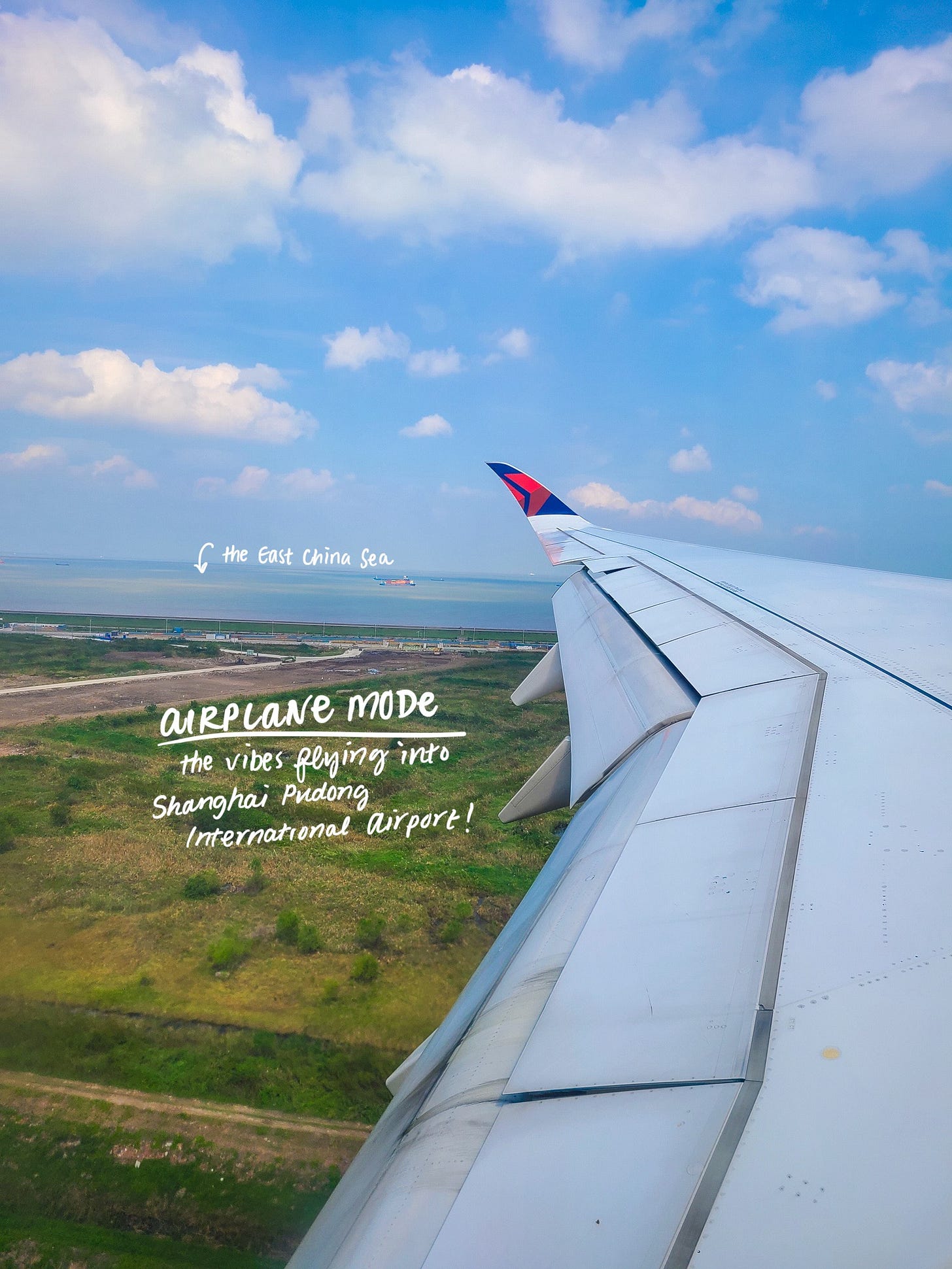
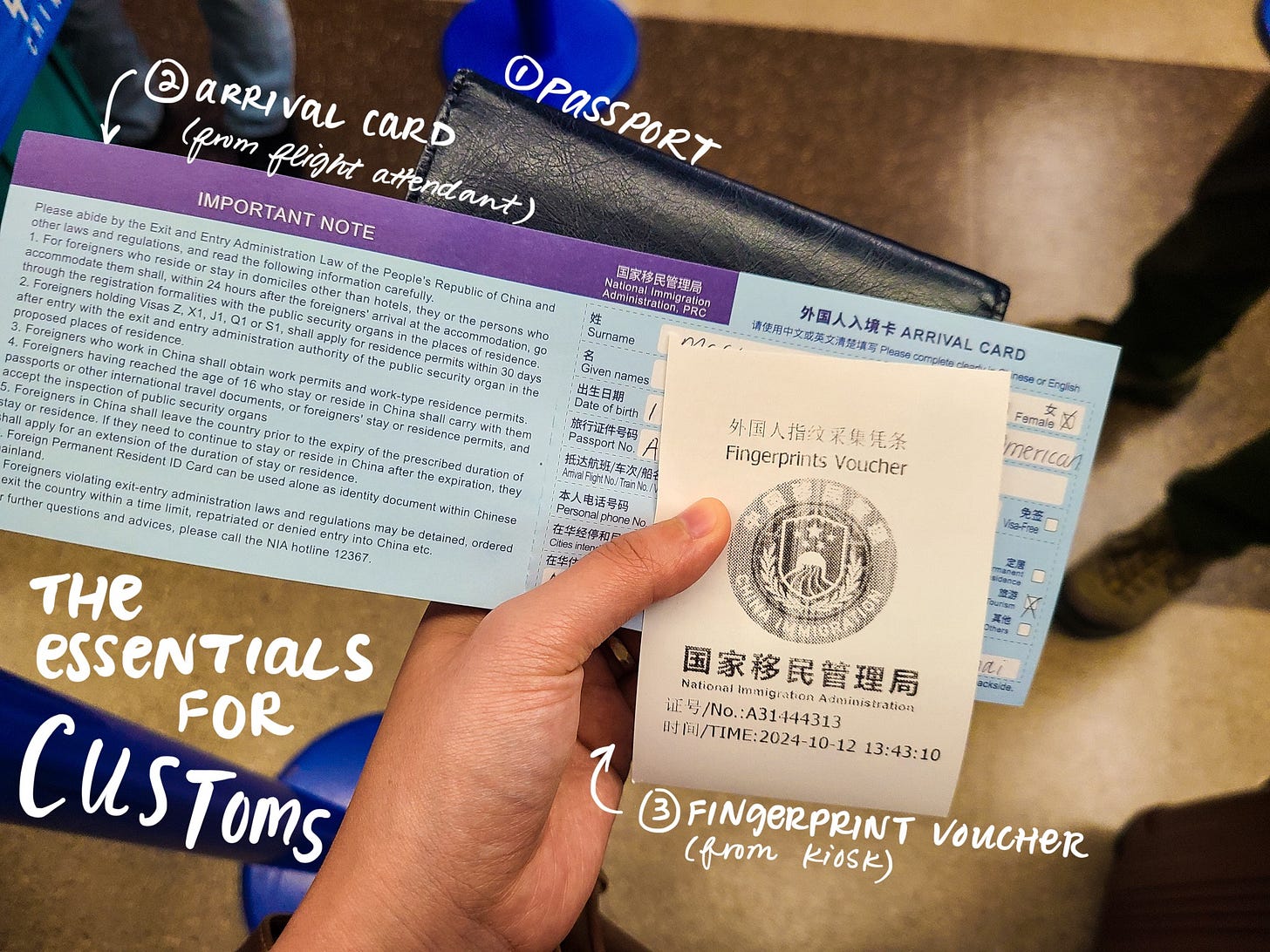


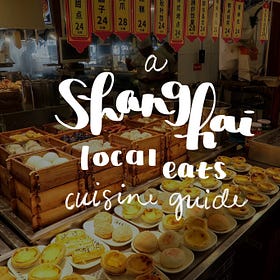
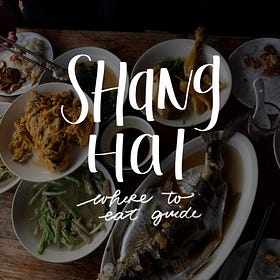
At it again with the ORGANIZATION!! I love how easy you make it to find everything 💕
so glad I didn't have to go through with renewing my visa this time around. Seems like a pain